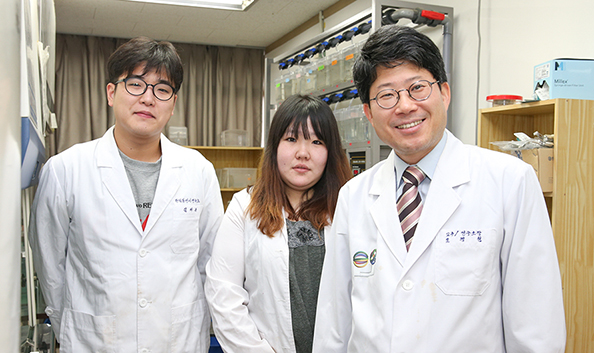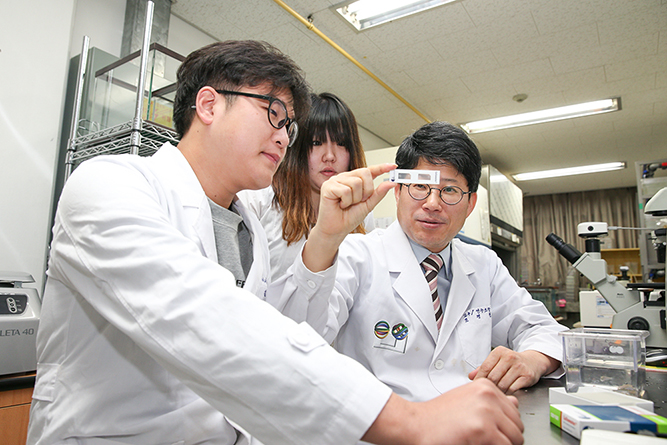School of Biotechnology Team Reveals Ultrafine Particles Toxin Generation Mechanism for the First Time in the World N
No.88829- Writer pr
- Date : 2015.12.16 10:29
- Views : 8022
|
Revealed mechanism for changes in blood protein and increase in saccharification, as well as skin cell aging promotion mechanism for the first time in the world
Research team recommends ‘avoid exposure for diabetic or chronic inflammation patients and pregnant women and young children’
[December 8, 2015]
 <YU research team that revealed the mechanism that causes toxicity of ultrafine particles for the first time in the world>
(from left to right, BK21 Plus Project Team Researchers Kim Jae-yong, Lee Eun-yong, Professor Cho Gyeong-hyeon)
A research team at YU made news by becoming the first in the world to reveal the mechanism that causes toxicity of ultrafine particles.
Ultrafine particles, which refer to particles having less then 2.5μm (micrometer, 1μm = 1mm/1,000) diameter, is known to heighten risk of atherosclerosis and diabetes, while also being harmful to pregnant women. However, details on the reason for it were unknown.
The YU BK21 Plus Project Team (Team Director, School of Biotechnology Professor Cho Gyeong-hyeon) observed the effects of ultrafine particles on blood serum lipoprotein, skin cells and vascular cells, as well as the physiological effects that appear when the embryos of zebrafish are exposed to ultrafine particles.
The research team carried out studies by receiving ultrafine particle specimens collected by the Seoul Meteorological Observation Station in January 2014 at the National Institute of Environmental Research Atmospheric Environment Research Bureau, which is a national research institute under the Ministry of Environment. The exposed the research subjects by exposing to ultrafine particles with 3ppm (part per million, 1/1,000,000) and 30ppm, and observed cellular changes after 48 hours.
 <The research team examines cellular changes caused by ultrafine particles.>
The research team revealed that ultrafine particles can cause an increase and transformation of saccharification of lipoproteins, acute cardiovascular toxicity, and skin cell aging. In addition, zebra fish embryos that were exposed to both materials that cause inflammation and ultrafine particles had a 19% increase in spinal development disorders compared to the control group, while the inflammation rate and death rate also increased by 4.3 times and 30%, respectively. In particular, when treating with ultrafine particles together with fructose that causes diabetes and substances that promote inflammation, it was found that risk of transformation of lipoproteins and cardiovascular diseases accelerated even further.
The research team said, "Through this study, it was confirmed that even if the ultrafine particle concentration is light, patients with inflammations, chronic diseases such as diabetes, gum diseases, and rheumatism arthritis, and pregnant women had higher risks," and added, "Patients with weak immunity functions, pregnant women, and young children should avoid exposure to fine particles as much as possible."
Meanwhile, the results of this study will be published in the December 2015 issue of 'Molecules and Cells', which is an international academic journal. |